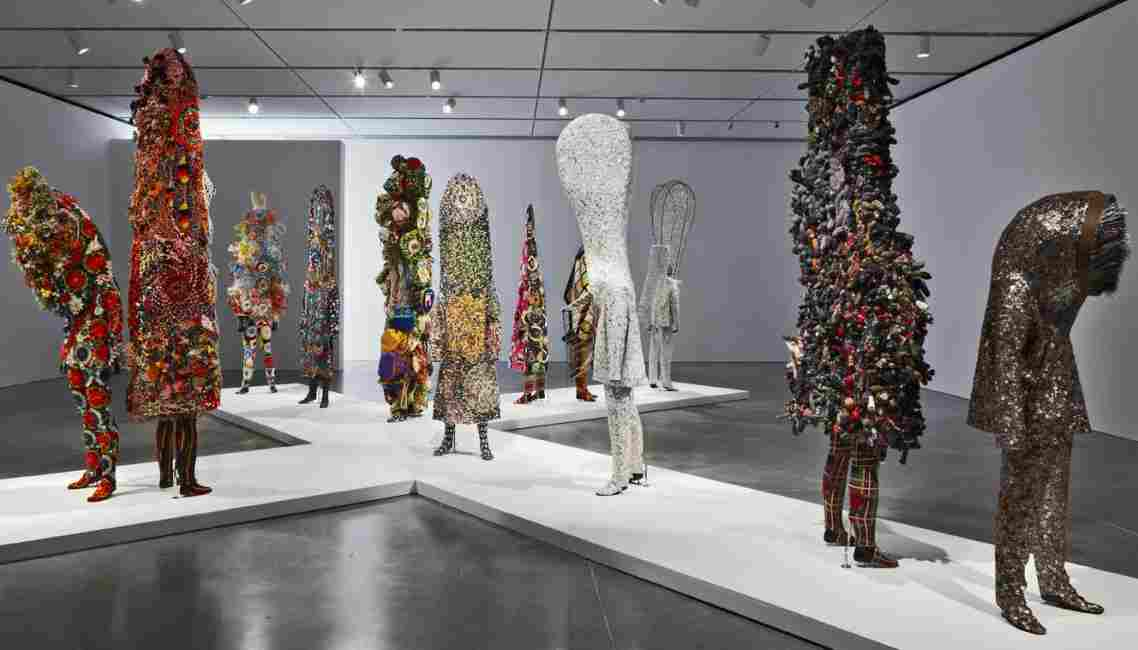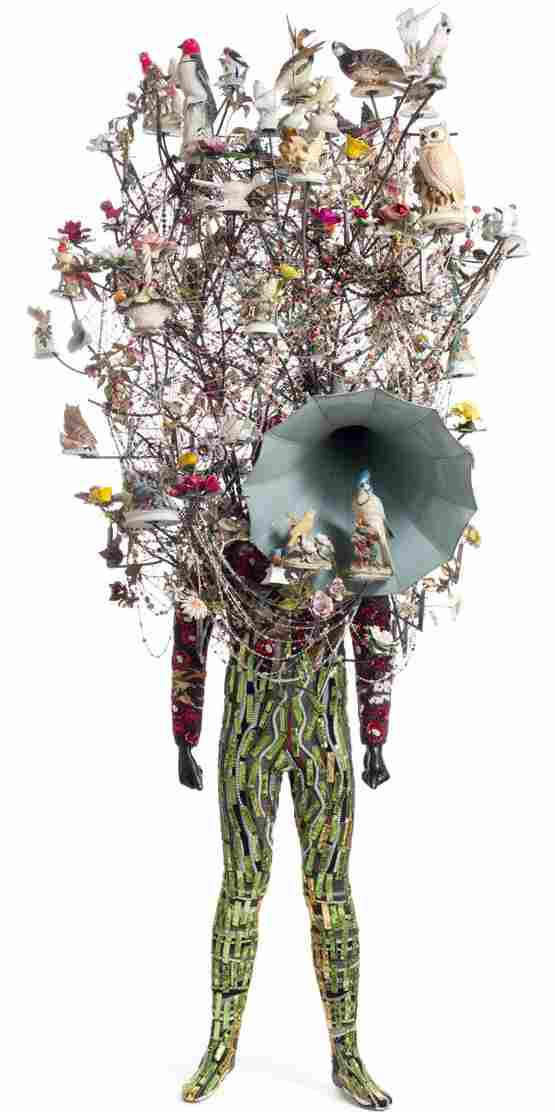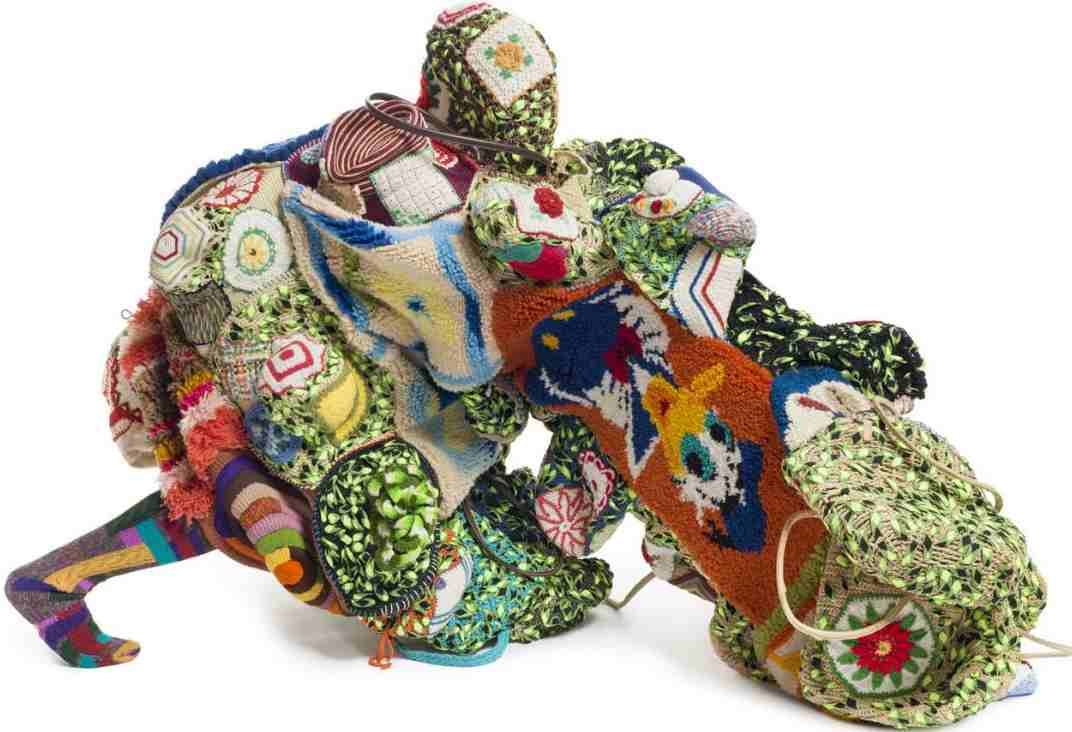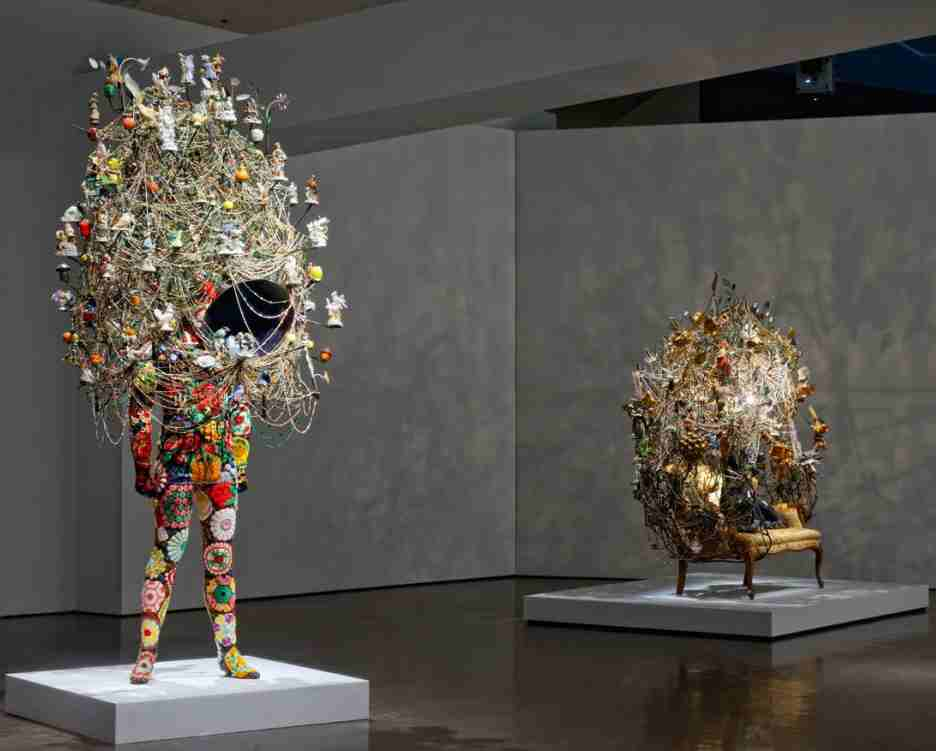|
|
NICK CAVE AND FUNK

reviewed by
ANTHONY MERINO
______________________________________
Anthony
Merino, renowned independent art critic, has published over
70 reviews. He is a ceramic
artist and has lectured internationally on contemporary
ceramics.
Contrary
to modern canons, the grotesque body is not separated from the
rest of the world.
It is not a closed, completed unit; it is unfinished, outgrows
itself, transgresses its own limits.
The stress is laid on those parts of the body that are open
to the outside world,
that is, the parts through which the world enters the body or
emerges from it.
Mikhail Mikhailovich Bakhtin, Rabelais and His World

Nick
Cave sews, weaves and fastens together debris and fabrics to
create fanciful suits of armor called Soundsuits (2004-2014).
Fibrous multi-hue conglomerations explode out of these outfits’
torso. On the surface the pieces read as festive; like erudite
Mardi Gras costumes. Held on the Tuesday before the Ash Wednesday,
Mardi Gras is one last hedonistic ritual prior to the imposed
 austerity
of Lent. Both Cave’s Soundsuits and Mardi Gras
costumes are flamboyant and overtly sexual. The carnival we
know today is a mere fossil of its origin. In his introduction
to Rabelais and His World, noted Russian literary theorist
Mikhail Mikhailovich Bakhtin writes -- “[A]ll were considered
equal during carnival. Here, in the town square, a special form
of free and familiar contact reigned among people who were usually
divided by the barriers of caste, property, profession, and
age.” All shared characteristics: surface frivolity, an
unreal quality and a subversive egalitarian intent are consistent
with a distinctly American music form -- Funk. austerity
of Lent. Both Cave’s Soundsuits and Mardi Gras
costumes are flamboyant and overtly sexual. The carnival we
know today is a mere fossil of its origin. In his introduction
to Rabelais and His World, noted Russian literary theorist
Mikhail Mikhailovich Bakhtin writes -- “[A]ll were considered
equal during carnival. Here, in the town square, a special form
of free and familiar contact reigned among people who were usually
divided by the barriers of caste, property, profession, and
age.” All shared characteristics: surface frivolity, an
unreal quality and a subversive egalitarian intent are consistent
with a distinctly American music form -- Funk.
One
of the leaders of the American funk movement was bandleader
George Clinton of Parliament Funkadelic. Perhaps the most meaningful
stylistic connection between the two is the sheer virtuosity
of their creations. Both artists construct the appearance chaos
through menageries of excess sensations. This takes extraordinary
skill. Both Cave and Clinton indulge the more base human appetite.
This seemingly superficial glee camouflages a far more subversive
intent of their work.
Cave’s
Soundsuits come from great pain. He made his first
Soundsuit in response to the Rodney King beating. On
the 3rd of March 1991, Mr. King was pulled over by the Los Angeles
police. A video surfaced that showed Mr. King being beaten on
the ground by several of the officers. Cave describes his response
to this video stating, “I started thinking about myself
more and more as a black man -- as someone who was discarded,
devalued, viewed as less than.” This tactic of coopting
a caustic reality into a defiant expression of joy transcends
disciplines links Cave and Clinton’s work with a fundamental
archetype.
The
harlequin, a stock character in Italian commedia del’arte
plays -- also embodies this archetype. Superficially both the
Soundsuits and the harlequin’s outfit are brightly
coloured and highly detailed. Slightly deeper, they are both
constructed from other’s debris. The original Harlequin
costume consisted of a peasant’s shirt. Torn and worn,
the outfit was mended with multi-coloured patches. This later
got magnified and become the multi-hued diamond grid. In talking
about his work in a March 31st, 2009 profile published in the
New York Times, Mr. Cave stated:
When
you’re raised by a single mother with six brothers and
lots of hand-me-downs, you have to figure out how to make those
clothes your own. That’s how I started off, using things
around the house.
This
ethic of repurposing becomes both the literal and metaphoric
theme of his work. Cave takes what the world gives him.
Going
deeper into the parallels, another linkage to the American Funk
music movement emerges. On a psychological level -- like the
harlequin character, Cave and Clinton embrace their status as
the magical and mysterious outsider. Being part of a society
involves an inherent conformity. Cave’s Soundsuits
and Clinton’s music both employ a garish horror vacui
aesthetic. Each artist loves to litter his works with flamboyant
artificiality. This is evidenced by Cave’s preference
for bright hues and metallic colors. Clinton furiously peppers
his music with  synthesized
notes, falsetto voices and deep base riffs. In part, each form
celebrates an appetite that would be considered best restrained
in a polite society. Cave and Clinton infuse their work with
a Neo-primitivism. Modernism is streamlined, economic and efficient.
Their work embraces the irrational and fanciful. While the branches
split in different directions -- both artists create work derived
from African music and dance. In doing so they ground their
work in a pre-modern period. synthesized
notes, falsetto voices and deep base riffs. In part, each form
celebrates an appetite that would be considered best restrained
in a polite society. Cave and Clinton infuse their work with
a Neo-primitivism. Modernism is streamlined, economic and efficient.
Their work embraces the irrational and fanciful. While the branches
split in different directions -- both artists create work derived
from African music and dance. In doing so they ground their
work in a pre-modern period.
Two
dynamics come into play here. First, they are asserting the
spiritual and illogical. The experience of life goes far beyond
the borders of either system, however. So the promotion of celebrating
the unknown is subversive. In speaking about the social function
of his work, Mr. Cave stated, “I was really thinking of
getting us back to this dream state, a place where we imagine
and think about now and how we exist and function in the world.
With the state of affairs of the world, I think we tend not
to take the time out to create that dream space in our heads.”
Cave suggests the realm of the subconscious and the imagination
can help us grasp our position in the world. The quote infers
that knowing how your fit in the world empowers you to change
how your fit in the world. This idea is a signature of George
Clinton’s lyrics. The sixth album released by Funkadelic,
Standing on the Verge of Getting it On, included the
song “Good Thoughts, Bad Thoughts,” in which Clinton,
along with co-writer Eddie Hazel, articulate an argument that
the subconscious is the place of appetites and imagination drives
truth.
Every thought felt as true
Or allowed to be accepted as true by your conscious mind
Take roots in your subconscious
Blossoms sooner or later into an act
And bears its own fruit
Good thoughts bring forth good fruit
Bullshit thoughts rot your meat
Think right, and you can fly
The kingdom of heaven is within
Free your mind, and your ass will follow
Clinton’s
observation that reality is not only rooted in your mind but
your subconscious uncovers a psychological link between his
and Cave’s work and the archetype of the Harlequin.
There is one deeper -- almost primal strata in which Cave’s
process parallels the archetype of the harlequin. Carl Jung
wrote about this archetype in looking at the work of another
artist, Pablo Picasso. In a 1932 article on the painter, Carl
Jung referred to the harlequin as a “ancient chthonic
god.” The underworld represents the subconscious, hence
where the power of Cave’s warriors comes from. Jung parallels
Picasso’s use of the harlequin with Jung’s Faust
stating:
Faust
turns back to the crazy primitive world of the witches' sabbath
and to a chimerical vision of classical antiquity. Picasso
conjures up crude, earthy shapes, grotesque and primitive,
and resurrects the soullessness of ancient Pompeii in a cold,
glittering light -- even Giulio Romano could not have done
worse! Seldom or never have I had a patient who did not go
back to neolithic art forms or revel in evocations of Dionysian
orgies. Harlequin wanders like Faust through all these forms,
though sometimes nothing betrays his presence but his wine,
his lute, or the bright lozenges of his jester's costume.
This
analysis highlights the strength of Cave’s process. In
response to the video of King’s beating, he did not just
delve into his subconscious. Cave engages the underworld of
his society.
Concluding
his essay on the archetype of the harlequin, Jung quotes Thus
Spoke Zarathustra, Nietzsche’s Übermensch, who
in chastising another character states “Your soul will
be dead even sooner than your body. Fear nothing more.”
This lamentation provides a context for the true heroic nature
of Cave and Clinton’s work. When faced with the prospect
of being “discarded, devalued, viewed as less than”
they choose defiance. After which, both artists create works
bold and defiant.
Images
courtesy of the artist and Jack
Shainman Gallery, New York.
|
|
|